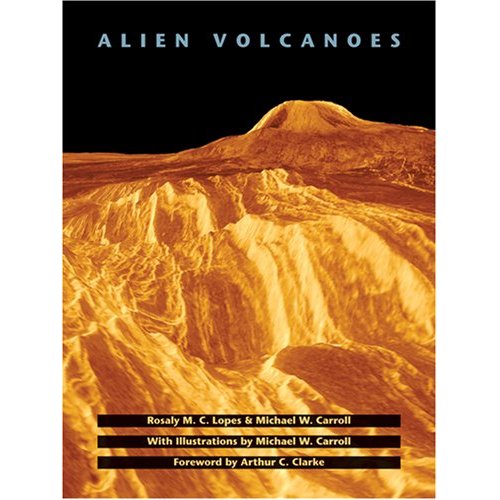[/caption]
Brilliant plumes of iridescent lava thrown skyward both awe and thrill us. Active volcanoes diminish our sense of importance as they shake the very ground and spread ash throughout the skies. But as Rosaly Lopes and Michael Carroll describe in their book “Alien Volcanoes“, these forceful displays dominate the shape of the Earth. As well, they are the prime candidates for being responsible for shaping many other nearby planets and moons.
Volcanoes act as release valves for Earth. Heat, whether from nuclear reactions or tidal pull, gets generated within Earth and needs to get out to the cold of space. In some locations, the heat slowly radiates in a predictable, almost controlled manner. At others, the heat builds up within Earth’s crust then bursts in a brief violent display of shear power. Bursts like these can release huge amounts of heat and greatly rearrange the landscape, as seen at Krakatoa. The resulting landscape reflects the type of heat flow. And, similar landscape occurs elsewhere in the solar system. Thus, the authors expect similar underlying processes for heat release, no matter where it takes place.
This book by Lops and Carroll brings together the scientific details and visual beauty of volcanoes throughout our solar system. Its beginning goes through the reasoning for the production of heat in Earth and other planets. It mentions that volcanoes have over 4 billions years of history, but the focus is on how they effect humans. From Iceland and the mid-Atlantic ridge to black smokers in the Pacific, the book both describes with words and illustrates with many pictures the way humans have been pummelled, cajoled and sustained by the heat and minerals forced out the Earth’s curst.
With this background, the authors then swing their gaze from Earth to other planets. Though probes are just beginning to acquire three dimensional views of planet surfaces, the authors provide sound evidence of volcanic activity. For example, Olympus Mons is an obvious volcano, but are the Martian caves really lava tubes or odd constructs of other processes? The authors suggest the former and provide sound reasoning. We also read that Venus has nearly 90 percent of its surface showing volcanic features. Even tiny Enceladus gets mentioned because of striking evidence that cryovolcanism occurs on its surface.
Yet, by starting with Earth and then stepping to other planets and moons, the authors demonstrate and utilize the commonality of volcanism. Enhancing this are pictures throughout the text that show common features: shields, domes, and flows. From this, the reader can appreciate and identify elements in foreign landscapes. And, this seems to be the goal of the authors, to share knowledge and perhaps incite a little emotional interest in this subject. And, they succeed wonderfully.
This book’s mixture of history, science, photography and artwork encapsulates volcanism into a captivating advertisement. Having a frame of reference that extends through hundreds of millions of years and across the solar system propels the reader off their chair. Perplexing images of incomplete ridges and fractures on distant moons builds the reader’s desire to know more. With this, the reader gets caught up into the scientific process. And this is how science books deliver, they translate specific technical detail into excitement and interest for the general, interested reader.
Blasts from volcanoes are so rare that they draw attention worldwide. But our world isn’t the only one with these amazing heat outlets as shown by Rosaly Lopes and Michael Carroll in their book “Alien Volcanoes“. We can’t effect these heat outlets nor predict bursts. However, with this book, we can look upon this land shaping process with acceptance, understanding and, still, a fair amount of awe.


thanks…